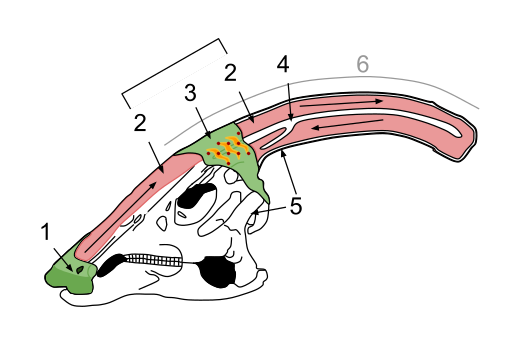Archivo: Parasaurolophus Cranial Crest

Descripción: Seen here is a Parasaurolophus skull with a view into nasal cavity of the cranial crest. It is hypothesized that the Parasaurolophus pushed air through its long cranial crest to make low register sounds that could be heard for miles. 1. Nostril 2. Sinus cavity 3. Skin 4. Intra Cranial bone 5. Skull 6. Cranial crest The system that the Parasaurolophus used to make its low register sounds starts with the nostrils. After air is drawn in through the nostrils, it travels through the entire sinus cavity. This cavity starts where the nostrils are and runs the length of the cranial crest. The air is moved to the end of the crest at which point it is pushed back toward the skull. This air flow is represented by the arrows in the diagram. After the air exits the crest, it enter the lungs. When the Parasaurolophus exhales, the air moves back out of the lungs and back through the sinus cavity of the cranial crest. Before the air exits the nostrils, it passes through the voicebox of the Parasaurolophus which has not been definitively located by paleontologists. The sound that is created by the inhaling and exhaling of the Parasaurolophus is in a very low register, and could be heard for miles. Paleontologist hypothesize that the Parasaurolophus used this as a means of communication between long distances. It is also hypothesized that the Parasaurolophus used its bellowing call to intimidate potential predators.
Título: Parasaurolophus Cranial Crest
Créditos: Trabajo propio
Autor(a): Jdistefano14
Términos de Uso: Creative Commons Attribution-Share Alike 3.0
Licencia: CC BY-SA 3.0
Enlace de Licencia: https://creativecommons.org/licenses/by-sa/3.0
¿Se exige la atribución?: Sí
Usos del archivo
La siguiente página enlaza a este archivo:

